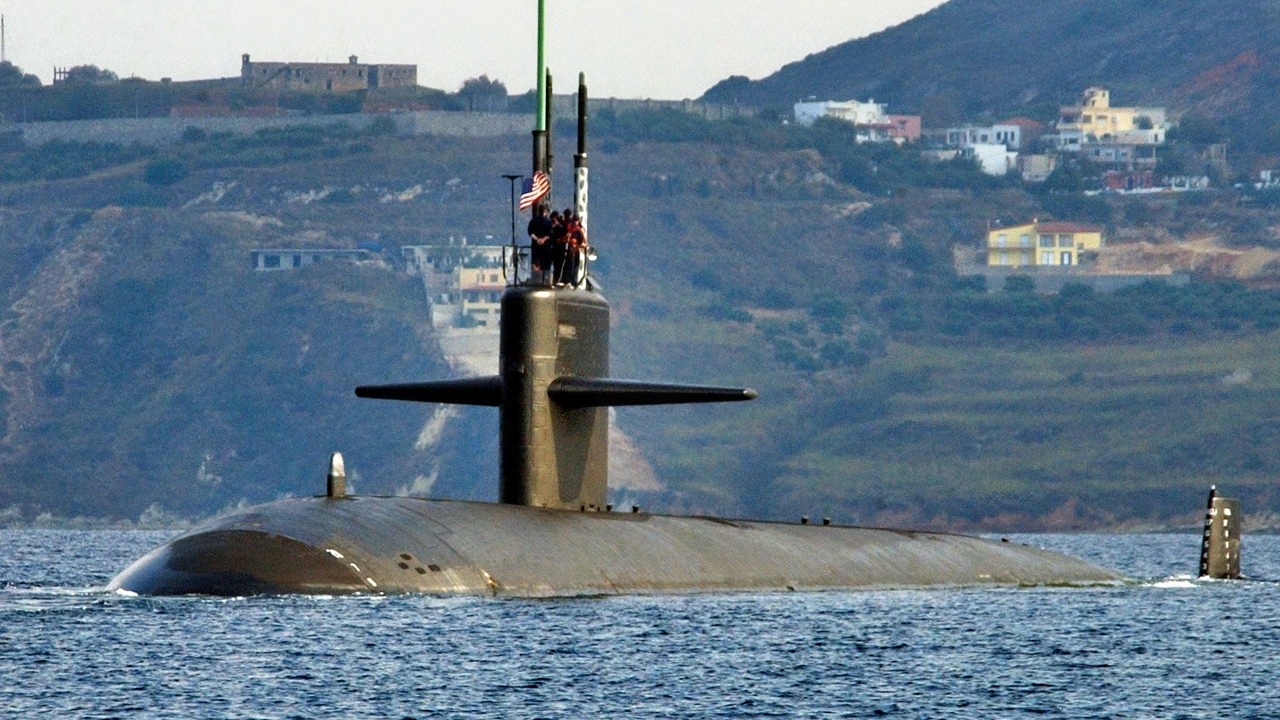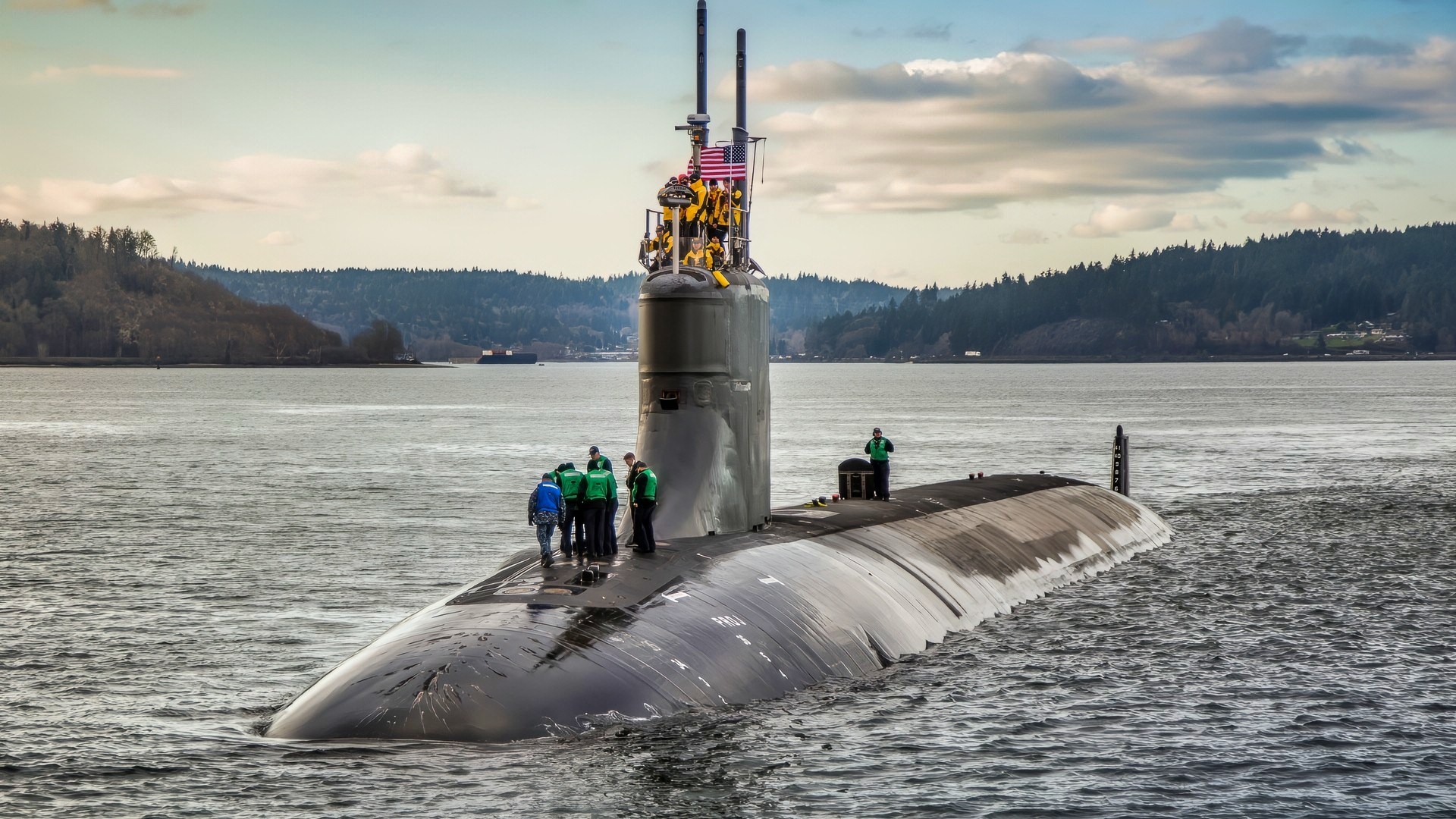Article Summary – The Seawolf-class was built to be the U.S. Navy’s ultimate Cold War hunter-killer sub, but the post-Soviet “peace dividend” killed the program after just three boats.
-With Los Angeles-class subs retiring fast and Virginia-class production lagging, that decision now haunts the fleet.

Port bow view showing US Navy (USN) Sailors manning a topside watch aboard the Los Angeles Class Attack Submarine USS NEWPORT NEWS (SSN 750), as the ship departs the harbor at Souda Bay, Crete, Greece following a port visit.

The Los Angeles class submarine USS San Francisco (SSN 711) shown in dry dock is having repairs made on its damaged bow. A new large steel dome about 20 feet high and 20 feet in diameter was put in the place of the damaged bow. San Francisco ran aground 350 miles south of Guam Jan. 8, killing one crew member and injuring 23. U.S. Navy photo (RELEASED)
-Seawolf hulls are ultra-quiet, fast, and ideal for stalking Russian and Chinese subs in deep, cold waters — precisely the missions multiplying today.
-Instead of the planned 29 boats, America got three, while rivals expand their undersea forces.
-The result: a Seawolf shortage that stinks at the very moment the Navy needs these predators most.
The Seawolf-Class Submarine Shortage Stinks
To ichthyologists, “seawolf” is another name for the Atlantic Wolffish (Anarhichas lupus), a rather gruesome-looking sea creature that survives in waters with temperatures as low as 30.2 to 51.8 degrees Fahrenheit (-1 to 11 degrees Celsius), and preys upon hardshell crustaceans, mollusks, and echinoderms. Old-school video game buffs, meanwhile, might remember the 1976-vintage game Sea Wolf, a submarine warfare-themed game manufactured by Midway (not to be confused with the epic World War II game)…
Speaking of sea creatures and submarines alike, the aforementioned eponymous fish inspired the name of the US Navy’s Seawolf class of nuclear-powered fast-attack submarines (SSNs). Like their scales and fins-bearing flesh and blood namesakes, these steel Seawolves can also survive extremely cold waters, and are deadly predators to mechanical prey, i.e., adversaries’ warships.
However, the Seawolf boats would also probably qualify for the Endangered Species List due to the fact that only three were built (commissioned in 1997, 1998, and 2005). And that’s a bad thing for the Navy.
Bottom Line Up Front (BLUF): The Seawolf Submarine Shortage Stinks (SSSS)
Why only three such subs, one might reasonably ask? Initially, a fleet of 29 was to be built over a decade-long period, but that was reduced to 12 hulls.
The Seawolf class showed great promise, envisioned as successors to the US Navy’s venerable Los Angeles-class SSNs, which were commissioned between 1974 and 1996.
Design work at the General Dynamics Electric Boat company commenced in 1983, with the notional intention of going toe-to-toe with the Soviet ballistic missile submarines (SSBNs), such as the Typhoon class, and attack submarines, such as the Akula-class boats.
Then came the collapse of the Soviet Union in 1991, which officially ended the Cold War; the resulting “peace dividend” threw a proverbial wrench into the works and cast serious doubts on the future viability of the Seawolf project.
As the Seaforces-online website explains, “This, in turn, led to the design of the smaller Virginia class. The Seawolf class cost about $3 billion per unit ($3.5 billion for USS Jimmy Carter), making it the most expensive SSN submarine and *second most expensive submarine ever*, after the French SSBN Triomphant class… The projected cost for 12 submarines of this class was $33.6 billion.” [Emphasis added.]
Well, as the saying goes, “Penny wise and pound foolish.” That “peace dividend” turned out to be a relatively short-lived pipe dream, as 20/20 hindsight now starkly shows us.
America’s “near-peer” Great Power competitors, Russia and China, continue to expand and modernize their submarine fleets, whilst America’s own submarine force is left holding the bag:
-Only 23 of the original 62 Los Angeles-class subs currently remain in service, and three more (USS Scranton [SSN-756]; USS Alexandria [SSN-757]; USS Annapolis [SSN-760]) are proposed for retirement between 2026 and 2027

Los Angeles-Class. Image Credit: Creative Commons.
-Meanwhile, the Virginia-class SSNs are coming along at a depressingly slow pace, with only 24 activated thus far out of the 69 planned, with 10 more under construction
-The Navy is so desperately short of the estimated 100,000 skilled workers needed to build the new boats that they’ve been running a BuildSubmarines recruiting push since November 2022.
Even a measly 12 Seawolves (let alone 29) would’ve gone a long way in mitigating the current shortfall of USN SSNs.
Where Are They Now?
USS Seawolf is currently homeported at Naval Base Kitsap in Washington; ditto for her two sister ships.
As another saying goes, “When life deals you lemons, make lemonade!”
Despite the financial challenges, the Navy is making the most of the available ships in the class. Case in point: In July 2020, USS Seawolf deployed to the Arctic area of responsibility (AOR), where she conducted special operations and pulled into multiple European ports, making history as the first US Navy deployment during the COVID-19 pandemic.
Semantic Sidenote
Going back to the discussion in the opening paragraph of this article, the naming of the Seawolf harkened back to the first half of the 20th century, when it was common practice for the Navy to name its submarines after fish and other aquatic creatures.

(Dec. 15, 2016) – The Seawolf-class fast-attack submarine USS Connecticut (SSN 22) departs Puget Sound Naval Shipyard for sea trials following a maintenance availability. (U.S. Navy photo by Thiep Van Nguyen II/released)
However, Adm. Hyman G. Rickover (“the Father of the Nuclear Navy”) put the kibosh on that tradition, with the assertion that “Fish don’t vote.”
Luckily for lovers of the old-school marine biological naming convention, Rickover retired in 1982, seven years before the USS Seawolf (SSN-21) had her keel laid.
However, the remaining two Seawolf boats, USS Connecticut (SSN-22) and USS Jimmy Carter (SSN-23), ended up without “fishy” individual names.
About the Author: Christian D. Orr, Defense Expert
Christian D. Orr is a Senior Defense Editor. He is a former Air Force Security Forces officer, Federal law enforcement officer, and private military contractor (with assignments worked in Iraq, the United Arab Emirates, Kosovo, Japan, Germany, and the Pentagon). Chris holds a B.A. in International Relations from the University of Southern California (USC) and an M.A. in Intelligence Studies (concentration in Terrorism Studies) from American Military University (AMU). He is also the author of the newly published book “Five Decades of a Fabulous Firearm: Celebrating the 50th Anniversary of the Beretta 92 Pistol Series.”
More Military
Taiwan’s F-16V Fighter Was Built to Fight China’s Air Force
5 Places World War III Could Break Out in 2026
The X-37B Space Plane Is Breaking All the Rules and Makes Chinese Generals Sweat










